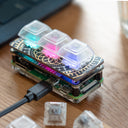Keybow Kit (3-key)
by Pimoroni



Keybow MINI is a 3-key version of our wildly-popular Keybow mini mechanical keyboard. Like its older sibling, Keybow MINI has RGB-illuminated, hot-swap, mechanical switches, and clear key caps. It's the perfect way to add a tiny macro pad to your desk, or to use as a little osu! controller.
This kit has everything you need (just add a Raspberry Pi Zero WH and micro-SD card) to build your own mini macro pad. It comes with your choice of clicky (Gold) or linear (Silver) Kailh Speed switches, and clear DSA-profile key caps that look incredible when lit up with the per-key RGB lighting. The fancy hot-swap Kailh sockets mean that there's absolutely no soldering required!
Kit includes*
- Keybow MINI PCB
- Switch plate
- Three Kailh Speed switches (Gold or Silver)
- Three clear DSA-profile key caps
- Acrylic baseplate
- Fixings and feet
- Micro-USB cable (50cm)
- Comes in a reusable mini kit box
*Just add a Raspberry Pi Zero WH and micro-SD card
It works great for media controls: map the keys to volume down / mute / volume up or previous track / play-pause / next track. You can use it as an osu! controller too. Or why not make some really complex multi-step macros to automate common tasks like opening a new email and pasting in some boilerplate text?
Keybow MINI works great with a Raspberry Pi Zero WH (with pre-soldered header), using the Zero's USB HID gadget mode so that it appears as a real keyboard when plugged into your computer with the included USB cable. We've built a completely custom, stripped-down, RAM-disk-based Keybow OS with a Lua interface to customise the layout and lighting on your Keybow MINI. It's Windows, Mac, and Linux-compatible.
Keybow MINI features
- Per-key RGB LEDs (APA102)
- Kailh hot-swap switch sockets (for Cherry MX-compatible switches)
- 40-pin female header
- I2C and SPI breakout header for add-ons
- Custom Keybow OS
- Compatible with Raspberry Pi 3B+, 3, 2, B+, A+, Zero, and Zero W
- Assembled size: 68.5x31.75x39mm
- Pinout
Construction
The Keybow MINI PCB has a 40-pin female header, like a regular pHAT, that plugs onto the 40-pin male header on the Raspberry Pi Zero W. The Pi is attached to the acrylic baseplate, and the whole thing is rigidly held together by metal standoffs. Rubber feet on the baseplate stop Keybow MINI from slipping around on your desk.
Check out our tutorial for all the details on how to build your Keybow MINI.
Mechanical switches
Keybow MINI comes with your choice of Kailh Speed Gold (clicky) or Silver (linear, non-clicky) switches. Both switches are light and smooth, and the gold switches have a satisfying click when pressed.
We've chosen clear DSA key caps for Keybow MINI, as they show off the per-key RGB LEDs really well. The slightly frosted finish on the clear key caps diffuses the light beautifully. Being DSA, the caps have a flat profile that suits the small size of Keybow MINI.
The switches slot into the PCB switch plate to hold them securely, and then push into the Kailh hot-swap sockets on the Keybow MINI PCB. This means that there's no soldering required, and you can easily change out the switches in the future, if you wish.
Note that if you want to use different switches with Keybow MINI, then you'll need to ensure that they have a recess on the underside for surface-mount LEDs.
Lighting
We've used the same tiny APA102 RGB LEDs that we use on our Picade Plasma PCBs, and there's one under each of the three keys. The LEDs sit in the cavity on the underside of the switch and shine up through, into the key cap.
There's a nifty way to light and animate the LEDs on Keybow MINI. You can create a PNG file with a coloured gradient or pattern, and it will be animated across the LEDs from the top of the image to the bottom. The width of the PNG determines how it's displayed.
You can manually set the LEDs on one or more keys, overriding the animation, or have them only light up when pressed.
There's a bunch of example animations to use, or you can create your own in your favourite graphics program.
Key mappings and layouts
The power of Keybow MINI is in how customisable it is. You can map each of the three keys to whichever keyboard keys you want, or even have them trigger a whole series of keypresses or strings of text to be entered.
Our Keybow software uses the on-the-go micro-USB port on the Raspberry Pi Zero W and USB HID gadget mode, so that it appears as a regular USB keyboard device when plugged into a computer.
The custom, stripped-down OS runs on a RAM-disk, meaning that it boots and runs quickly, it's robust against being unplugged, and there's no risk of SD card corruption.
To customise your Keybow MINI layout and lighting, just pop the micro-SD card out and edit the keys.lua file on your computer.
Note that you'll need to add keybow.use_mini() to the setup function in your key layout file to remap the keys to Keybow MINI's smaller layout, and use handle_minikey_xx for the name of each mapped key's function.
We no longer stock this product
It's sad to say goodbye but sometimes we have to retire products to make way for new things.
Need a large quantity or a customised version? We may be able to help! Contact wholesale@pimoroni.com to discuss a custom build.
Shop with confidence – we've been serving the hobbyist electronics, Maker, and retro gaming communities since 2012.
- Satisfaction or refund guarantee
- Worldwide shipping via mail or courier
- 57,000+ customer reviews
- Secure website and payments
